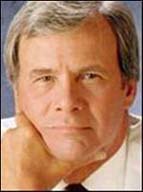Tom Brokaw
born February 6, 1940, in Webster, S.D. Raised in a small town with his two brothers, becomes interested in broadcasting while still in high school. After a brief attendance at the Univ. of Iowa, Brokaw studied political science at the Univ. of So. Dakota. He moved from radio to television, when he landed a job in Omaha after his graduation.
Brokaw started out with a $100 salary in his days in Omaha, a far cry from the 7-figure salary he commands today as the managing editor and sole anchor of NBC Nightly News with Tom Brokaw, He joined NBC in 1966. As the White House correspondent for NBC News during Watergate, Brokaw moved up the ranks as anchor of "Today on NBC" and then became sole anchor of the top rated "Nightly News" in 1983.
Brokaw was the first American journalist to secure a one-on-one interview with Mikhail Gorbachev and the only network anchor to personally cover the fall of the Berlin Wall. He's also the first to have an exclusive interview with the Dalai Lama, and the first anchor to report on human-rights abuses in Tibet.
Brokaw has taken the Nightly News to Beirut, the streets of Kuwait & Somalia, and to the White House lawns. He has covered every Presidential election since 1968. He is presently contributing anchor for Dateline NBC and program anchor for MSNBC. He has won almost every journalistic award out there, including 2 DuPonts, a Peabody, and 7 Emmys.
To add to the many articles he has written in publications like The New York Times, and Newsweek, Brokaw became a best-selling author in 1998 with the release of his book, "The Greatest Generation", dedicated to the Americans who were raised during the Great Depression, fought in WWII and built the America we know today.
Brokaw has three daughters Jennifer, Andrea and Sarah. He lives with his wife Meredith in New York and on a ranch in Montana. Brokaw does share his wealth, as he volunteers for Habitats and donated $250,000 toward a hiking and biking trail in his former hometown, Yankton, South Dakota.
|

 |